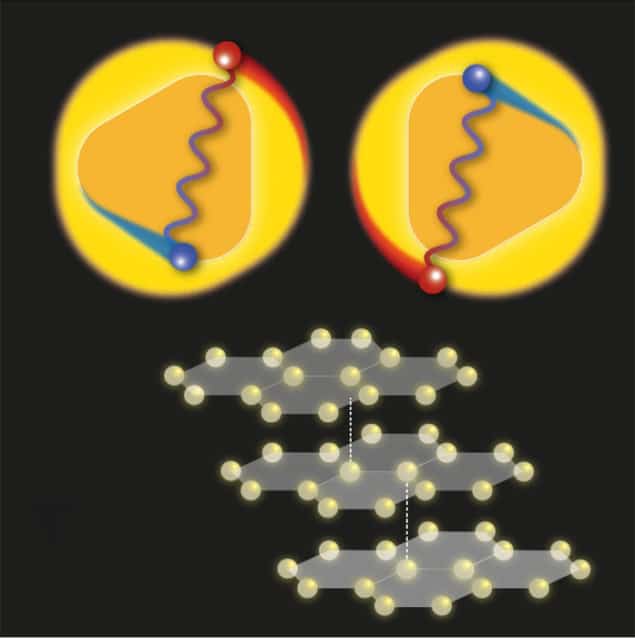New explanation emerges for robust superconductivity in three-layer graphene
15 Mar 2022 Isabelle Dumé

Last year, experimentalists at Harvard University in the US made an unexpected discovery: three layers of graphene are better than two at conducting electricity without resistance. At the time, the reasons for this unusual superconducting behaviour were unclear. Now, however, theorists in Austria and Israel have come up with an explanation that sheds more light on the origins of superconductivity in trilayer graphene, while also helping to explain other anomalies in recent experiments on this 2D carbon material.
Graphene is an atomically-thin sheet of carbon atoms arranged in a 2D hexagonal lattice. When two sheets of graphene are placed on top of each other and slightly misaligned, the positions of the atoms form a moiré pattern or “stretched” superlattice that dramatically changes the interactions between their electrons. The degree of misalignment is very important: in 2018, researchers at the Massachusetts Institute of Technology (MIT) discovered that at a “magic” angle of 1.1°, the material switches from being an insulator to a superconductor. The explanation for this is behaviour is that, as is the case for conventional superconductors, electrons with opposite spins pair up to form “Cooper pairs” that then move though the material without any resistance below a certain critical transition temperature Tc (in this case, 1.7 K).
Three years later, the Harvard experimentalists observed something similar happening in (rhombohedral) trilayer graphene, which they made by stacking three sheets of the material at small twist angles with opposite signs. In their work, the twist angle between the top and middle layer was 1.5° while that between the middle and bottom layer was -1.5°. By measuring the current that circulated through the layers when a voltage was applied to them, the researchers found that trilayer graphene remains superconducting at higher temperatures than is the case in two-layer graphene. Indeed, the measured Tc was about 40% higher, at 2.3 K. They also found evidence of something even more surprising: superconductivity in the trilayer system seemed to involve strong interactions between electrons, rather than weak ones as is the case in most conventional superconductors.
Natural allotrope of carbon
The bilayer and trilayer graphene materials in these studies must be constructed layer by layer, and their mechanical instability introduces certain complications for scientists seeking to explain their properties. For this reason, theorists led by Maksym Serbyn and Areg Ghazaryan from the Institute of Science and Technology (IST) Austria and Erez Berg and Tobias Holder from Israel’s Weizmann Institute of Science chose instead to study superconductivity in crystalline rhombohedral trilayer graphene. Although rare, this allotrope of carbon does occur naturally, and is mechanically stable.
In this material, the researchers identified two further phenomena that they say are difficult to reconcile with conventional superconductivity. The first, Ghazaryan explains, is that above a threshold temperature of about 13 K, the electrical resistance of the material should increase linearly with increasing temperature. However, previous experimental work found that the rate of increase remained constant up to 23 K.READ MORE

The second phenomenon is that pairing between electrons of opposite spin implies a coupling that contradicts another experimentally observed feature: the presence of a nearby configuration in which the spins are fully aligned – that is, magnetism. “In our work, we show that both these observations can be explained if one assumes that an interaction between electrons provides the ‘glue’ that holds electrons together,” Serbyn adds. “This leads to unconventional superconductivity.”
The theorists also found that the material has two so-called Fermi surfaces (the boundary between occupied and unoccupied electron energy states that defines many of properties of metals and semiconductors) with a circular shape. According to a theory from the 1960s, such circular surfaces favour a mechanism for superconductivity based only on electron interactions.
The findings are detailed in Physical Review Letters.

Isabelle Dumé is a contributing editor to Physics World
from physicsworld.com 7/4/2022
Δεν υπάρχουν σχόλια:
Δημοσίευση σχολίου